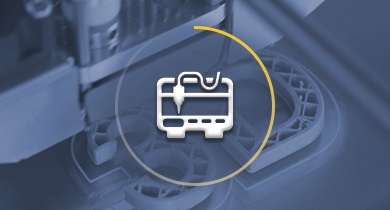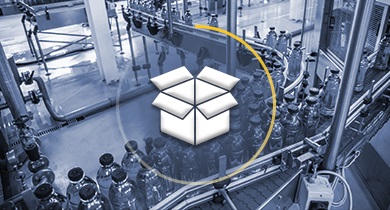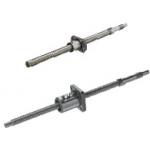Ball screws / compact flange, square flange / diameter 6, 8 / pitch 1, 2 / C3, C5, C7 / preloaded, 5µ, 30µ / steel / 58-62HRC
Part Number
Once your search is narrowed to one product,
the corresponding part number is displayed here.
- Drawing / Specifications
- 3D Preview 3D preview is available after complete configuration
- Part Numbers
- More Information
- Catalog
- Technical Information
Technical Drawing - Ball Screws

Open the technical drawing in the new window
Available dimensions and tolerances can be found under the tab More information.
Basic Properties (e.g., material, hardness, coating, tolerance) - Ball Screws
| Nut Type | Type | Accuracy Grade | Shaft Dia. | Lead | Screw Shaft | Nut | ||
| Material | Hardness | Material | Hardness | |||||
| Compact Nut | BSX | C3 | 6, 8 | 1, 2 | EN 1.7242 Equiv. | Carburized 58~62HRC | EN 1.7264 Equiv. | Carburized 58~62HRC |
| Standard Nut | BSS | C5 | 8 | 2 | ||||
| BSSE | C7 | |||||||
Further specifications can be found under the tab More information.
Composition of a Product Code - Ball Screws
| Part Number | - | L | |
| BSX0601 BSS0802 BSS0802L BSS0802G | - - - - | 185 200 210 210 | (L Type Greased) (G Type Greased) |
Alterations - Ball Screws

General Information - Ball Screws

Ball Screw Selection Details
- Material: steel
- Coatings: uncoated, LTBC coating, phosphate conversion coating
- Heat treatment: up to 62HRC
- Precision category: C3, C5, C7, C10
- Precision classes: precision class, standard class
- Slope: 1 to 32 mm
- Outer diameter: 6 to 32 mm
- Length (mm): 100 to 2000
- Nut shape: round flange, square flange, compact flange, block shape
Description/Basics
Ball screws are intended for converting rotary motion to linear motion. This can also be done in reverse order from linear to rotary motion. With the ball screws, this is achieved extremely precisely due to their low play. In mechanical engineering, the ball thread drive is an indispensable feature and is indispensable in precision applications. These work in horizontal and vertical orientation, allowing to shift, raise and lower devices.
The ball screws are often driven by motors and shaft couplings, or manually via rotary/crank handles.
When utilising a keyway, it is recommended using a machine key, as these can be combined excellently due to the manufacturing tolerances.
For a smooth process, it is recommended installing the ball screw with a fixed bearing and a floating bearing. This ensures that the ball screw does not bend due to compression and generate vibrations. For this purpose, MISUMI offers the right support units drives in various designs. For more information on how to install ball screws, see the Installation Instructions available as a PDF.
Ball screw nuts are available in different shapes. These enable versatile utilisation, even in confined spaces. Due to their high precision, the ball screws can also provide a high level of repeatability that is necessary in precise positioning applications. These can be utilised, for example, for measuring devices or in 3D printing. It is recommended to use a pre-stressed ball screw for highly precise applications. Due to the pre-tensioning, the axial play is almost zero unlike a conventional ball screw. In addition, MISUMI offers single axis actuators (locating units) for such applications, which as drives are already equipped with precise ball screws.
In smaller applications, a slide screw or a so-called miniature screw drive can be used. Due to their design, these are very compact, but suitable for lower axial loads.
If very high forces occur, a lead screw could also be considered.
Which ball screw is the right one for your application must be calculated based on the existing factors and influences. You can use the selection Ball Screws that is available as a PDF for this purpose. You can also find the service life calculation in this link.
Application Examples - Ball Screws

Application example for positioning stages
(1) Linear guide accessories, (2) Standard linear guide, (3) Table plate (meviy), (4) Ball screw, (5) Support units

Application example for the ball screw
(1)) Support units, (2) Ball screw nut stops, (3) Ball screw, (4) Ball screw nut mountings

Application example for a lifting device
(1) Ball screw, (2) Standard linear guide, (3) Support units, (4) Table top (meviy)

(1) Ball screw, (2) Standard linear guide, (3) Support units, (4) Table top (meviy)
Industrial Applications




Part Number:
- In order to open the 3D preview, the part number must be fixed.
3D preview is not available, because the part number has not yet been determined.
Part Number
|
|---|
| BSS0802-[100-210/1] |
| BSS0802G-[100-210/1] |
| BSS0802L-[100-210/1] |
| Part Number | Minimum order quantity | Volume Discount | RoHS | Nut Type | Accuracy Grade | Screw Shaft O.D. (mm) | Lead (mm) | Preload | Axial Play | Circuit System | Number of Circuits (Rows x Windings) | Shaft Overall Length L (mm) | Basic Load Rating Dynamic Rating (N) | Basic Load Rating Static Rating (N) | Grease Type | Screw Shaft Surface Treatment | |
|---|---|---|---|---|---|---|---|---|---|---|---|---|---|---|---|---|---|
| 1 | 7 Days | 10 | Standard Nuts | C5 | 8 | 2 | Not Preloaded | 0.005 or Less | Tube Type | 1 x 2.5 | 100 ~ 210 | 1950 | 2600 | Standard | - | ||
| 1 | 9 Days | 10 | Standard Nuts | C5 | 8 | 2 | Not Preloaded | 0.005 or Less | Tube Type | 1 x 2.5 | 100 ~ 210 | 1950 | 2600 | Type G | Not Provided | ||
| 1 | 9 Days | 10 | Standard Nuts | C5 | 8 | 2 | Not Preloaded | 0.005 or Less | Tube Type | 1 x 2.5 | 100 ~ 210 | 1950 | 2600 | Type L | - |
Loading...
Technical Drawing - Ball Screws

Open the technical drawing in the new window
Specification Table - Ball Screws
| Nut Type | Accuracy Grade | Part Number | 1mm Increment | Y | Ball Dia. | Ball Center Dia. | Screw Root Dia. | Number of Circuits | Basic Load Rating | Axial Play | Preload Torque N • cm | Twisting Direction | |||
| Type | Screw Shaft O.D. | Lead | L | C (Dynamic) kN | Co (Static) kN | ||||||||||
| Compact Nut | C3 | BSX | 06 | 01 | 80~205 | L-40 | 0.800 | 6.24 | (5.3) | 1 turn, 3 rows | 0.55 | 1.15 | 0 (Preloaded) | 1.3 or Less | Right |
| 08 | 01 | 80~255 | L-57 | 8.24 | (7.3) | 0.65 | 1.6 | 1.8 or Less | |||||||
| Standard Nut | 08 | 02 | 100~240 | 1.5875 | 8.3 | (6.6) | 2.5 turns, 1 row | 1.22 | 1.3 | 0.3~2.6 | |||||
| C5 | BSS | 100~210 | 1.95 | 2.6 | 0.005 or Less | 0.5 or Less | |||||||||
| C7 | BSSE | 0.030 or Less | - | ||||||||||||
Alterations - Ball Screws

More Information
Basic information
| Type | Precision | Conditions of Use | Standard | Twisting Direction | Right |
|---|---|---|---|---|---|
| Nut structure | 1-fach | Nut Size | Standard |
Configure
Basic Attributes
-
Nut Type
-
 Standard Nuts
Standard Nuts
-
-
Screw Shaft O.D.(mm)
-
Lead(mm)
-
Preload
- Preloaded
- Not Preloaded
-
Axial Play
- 0 (Preloaded)
- 0.005 or Less
- 0.030 or Less
-
Number of Circuits(Rows x Windings)
- 3 x 1
- 1 x 2.5
-
Shaft Overall Length L(mm)
-
Grease Type
- Standard
- Type G
- Type L
-
Screw Shaft Surface Treatment
- Not Provided
-
Type
- BSS0802
- BSS0802G
- BSS0802L
- BSSE0802
- BSSE0802G
- BSSE0802L
- BSX0601
- BSX0801
- BSX0802
-
Accuracy Grade
- C3
- C5
- C7
-
Filter by CAD data type
- 2D
- 3D
Filter by standard shipping days
-
- All
- 7 Days or Less
- 9 Days or Less
Optional Attributes
- The specifications and dimensions of some parts may not be fully covered. For exact details, refer to manufacturer catalogs .
Frequently Asked Questions (FAQ)
-
Question:
How do you mount a ball screw drive?
-
Answer:
A ball screw should be stored with a fixed bearing and a floating bearing. The fixed bearing should ideally be installed on the engine side or the drive side. Fixed bearing housings come already equipped with angular contact ball bearings to absorb axial forces. This combination makes ball screws an ideal candidate for positioning. However, a preloaded threaded drive should be selected for very high precision as it has very little axial play.
-
Question:
Why should a fixed and floating bearing be used?
-
Answer:
A fixed bearing housing is often used on the drive side. The floating bearing with housing, on the other hand, allows a small axial deviation and thus compensates for a change in length or a length tolerance. This prevents compression and bending of the ball screw and an imbalance through the length compensation. This may already occur by heating the spindle or application. Fixed and floating bearings are recommended in many rotary applications.
-
Question:
How does a ball screw work?
-
Answer:
A ball screw works similarly to a profile rail guide . In the nut of the ball screw, balls are in a closed ball circulation, which are guided to the spindle by the circular alignment. Thus, an unlimited stroke is theoretically possible, which, however, is limited by the length of the spindle. It is important to ensure that the nut of the ball screw is not removed from the spindle, because the balls can fall out as a result.
-
Question:
Why does the spindle oscillate in a ball screw drive?
-
Answer:
One possible cause for this could be that the ball screw is exposed to excessively high rotational speeds. The permissible rotational speed should not be higher than 80% of the critical speed. Here, attention should be paid not only to the visibly rotating components, but also to the rotational speed of the balls. Further information can be found in the ball screw driver selection as a PDF. Another possibility for the spindle to oscillate could be a compression of the spindle. Therefore, it is important to install a ball screw with a fixed bearing and a floating bearing so that these stresses can be compensated through a floating bearing. MISUMI offers this as ready-to-install bearing housings.
-
Question:
Is the ball screw nut removable?
-
Answer:
The ball screw nut or ball wrap nut should not be removed from the lead screw. There is a risk that the balls will fall out of the nut. This also means that the nut should not be extended over the threaded surface of the spindle. To remove the nut, you can work carefully with a transition shaft with the appropriate core diameter. However, MISUMI also offers an option [TAS] that provides a transition shaft with the ball screw drive. If a ball screw with reverse ball screw is required, the option [RLC] can be supplied with the ball screw nut installed in reverse.
-
Question:
Can you replace just the ball screw nut?
-
Answer:
A ball screw drive should always be replaced as one unit. If damage or wear has already occurred on the spindle, the accuracy of the ball screw drive can no longer be guaranteed. Therefore, it is always recommended replacing spindle and nut together. In addition, the ball screw nut should generally not be removed from the spindle. As a result, the balls that are necessary for the transmission of force may fall out.
-
Question:
How long does a ball screw lasts?
-
Answer:
How long a ball screw can withstand an application depends on many factors. Therefore, it is not possible to say generally how long a ball screw will last. When a ball screw should be replaced, it must be determined mathematically. In the following link, you will find the appropriate calculation formula for the lifetime available as a PDF.
-
Question:
How large is the axial play of a ball screw?
-
Answer:
The axial play varies depending on the precision class and size of the ball screw. You can find the appropriate axial play for different ball screws under the selection Ball Screws available as a PDF .
-
Question:
What must be considered when installing a ball screw?
-
Answer:
When installing a ball screw spindle, more must be taken into account than just ensuring that it is installed tension-free. There are a few things you should observe even before installation. You can view these as a PDF under Precautions.
-
Question:
Are the ball screws lubricated?
-
Answer:
The ball screws from MISUMI are pre-greased. Various lubricants are available for this purpose. Lithium-saponified lubricants are used as standard lubricants. In addition, MISUMI offers heat-resistant lubricants or lubricants suitable for cleanrooms. You can find further information under Installation and Maintenance available as a PDF.
MISUMI Unit еxample related to this product
Tech Support
- Technical Support
- Tel:+49 69 668173-0 / FAX:+49 69 668173-360
- Technical Inquiry









